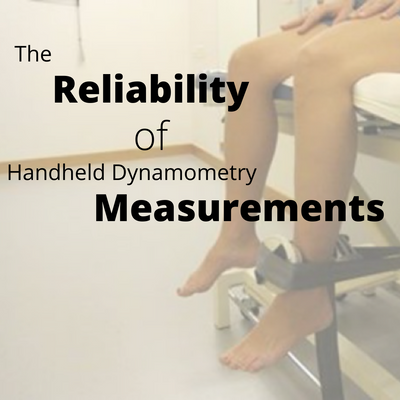 30th Apr 2021
30th Apr 2021
The Reliability of Handheld Dynamometry Measurements
Both handheld dynamometry (HHD) muscle testing and manual muscle testing (MMT) are considered acceptable methods for measuring muscle strength with the validity of both correlating well with each other as well as performance of functional activities such as sit-to-stand (STS), gait, and stair ascent. However, HHD is recommended as the method of choice for evaluation of isometric muscle strength of single muscle groups and is more portable and affordable than an isokinetic dynamometer (IKD), which is considered the gold standard for muscle strength measurements. Manual muscle testing has been used for over a century and involves the observation, palpation, and force application by an examiner to determine the strength of a muscle or muscle group and rates the muscle group being tested (scale of 0 to 5) based on a somewhat subjective measure of the degree of force applied. For example, if a muscle is incapable of producing movement at a joint, palpation and observation are used to discern whether the muscles being tested are active. If the muscles produce movement at the joint, observation is used to estimate the proportion of range of motion produced at the joint. Where movement is performed through a full range of motion, the examiner then applies a break-test force to determine and grade the magnitude of muscle force.
Handheld dynamometry is a procedure by which a dynamometer held in the hand of a tester applies a counter-force against a maximal contraction movement force and is measured in pounds, Newtons, or kilograms of force. Data obtained by HHD has been shown to correlate significantly with measurements obtained with an isokinetic dynamometer. Further, HHD has been shown to detect minimal changes giving more precise data for research and identification of minimal changes that prove important in measuring progress overtime.
How to Ensure the Reliability of Handheld Dynamometry
The acceptable reliability of both HHD and MMT can be impacted by the ability of the tester to apply adequate counter-force to that of the muscle(s) being tested. As such, if the tester has inadequate strength to properly and stably (isometrically) apply the needed counter-force, especially against larger muscle groups such as knee extensors and hip abductors and extensors, then the maximum force the tester can measure is limited by his or her own strength.
To prevent or minimize this, the following guidelines and recommendations should be followed to ensure the best reliability for those conducting HHD testing.
1.Those administering HHD muscle testing should be properly trained and have experience in muscle testing.
2.A standard and well accepted protocol should be followed. It is also recommended that the test value be the average of 2 measurements.
3.Instruction should be given to the subject/patient to apply their muscle force gradually and increasingly to maximum against the dynamometer over a period of a few seconds.
4.The examiner should follow general exercise testing guidelines to ensure better control of counter-force application and amount. They are:
a.Stabilize the proximal segment of the joint/muscle group being tested
b.Whenever possible apply the resistive force (dynamometer) at a 90° angle against the segment/bone that the muscles are causing the rotary movement. This will help ensure that 100% of the applied resistance is counter to the muscles being tested.
c.Apply the resistive force to the distal end of the distal segment/bone. This will help ensure a better mechanical advantage for the tester in applying a resistive force.
5.Where adequate tester strength is insufficient to maintain a static or isometric position of resistance against the muscle group and joint movement being tested, the tester should use a belt to stabilize the dynamometer against movement. For example, if testing quadriceps strength in the seated knee extension, a belt could be placed around the leg of a table or other immoveable structure, thus limiting movement.

6.Consider the prone standing position (hip is flexed placing the hip extensor muscle on stretch maximizing actin-myosin availability sites for a more favorable length-tension relationship for force production.

7.When measuring certain muscle groups/joint movements, the examiner could stabilize themselves with a belt that would in turn allow them to apply the resistance without being moved.
By adhering to these guidelines, the force applied by the examiners should not be a limiting factor influencing the reliability of their measurements.
References
- Bohannon RW. Considerations and Practical Options for Measuring Muscle Strength: A Narrative Review. BioMed Research International. 2019; 2019: 8194537, PMID 30792998
- Pierrette Baschung Pfister. Manual Muscle Testing and Hand-Held Dynamometry in People with Inflammatory Myopathy: An Intra- and Interrater Reliability and Validity Study. PLoS. 2018; 13(3): 30194531, PMID: 29596450
- Keep, Heather, et al. Validity of the Handheld Dynamometer Compared with an Isokenetic Dynamometer in Measuring Peak Hip Extension Strength. Physiotherapy Canada. Winter 2016; 68(1): 15-22, PMID: 27504043
Lynn Perkes is a full-time faculty member at Brigham Young University-Idaho teaching courses in Kinesiology and Biomechanics, Applied Kinesiology and Assessment, Therapeutic Exercise, and Physical Therapist Assistant classes. He writes part time for ProhealthcareProducts.com, which sells healthcare, therapy, fitness, and personal protective equipment products.





